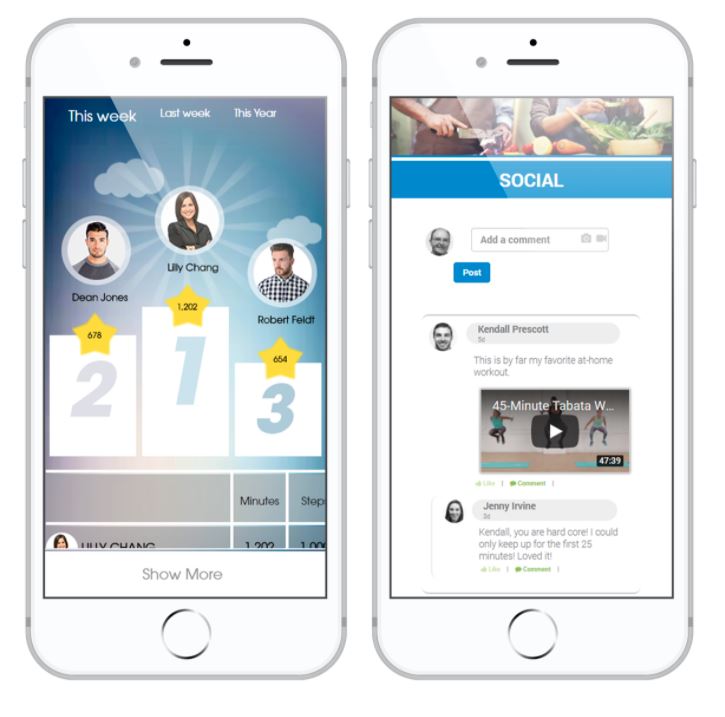A well organized employee wellness program can produce important outcomes such as improved employee health behaviors, lower health risks, and reduce health care costs. They are also effective at improving employee morale and productivity.
As any good business owner knows, a healthy and happy employee is a crucial aspect of maintaining a healthy, thriving business. Healthy, happy employees, however, is not something that happens organically—without a system in place that creates and cultivates it, problems, both social and professional are bound to turn up.
This is where employee wellness programs come in.

In this article, we’ll outline a comprehensive list of programs you can incorporate to promote and maintain employee wellness across a number of industries and organizations—when it comes to the mental, social, and physical health of your employees, there are going to be some obvious structural differences between worksites, but the principle underlying all employee wellness programs remains the same: the creation of a healthy work environment that facilitates health, morale, social cohesion, and productivity among the workforce.
What is an Employee Wellness Program?
An employee wellness program is any worksite activity designed to support better employee health. These activities often include medical screenings, incentives for healthy behaviors, behavior change interventions, health coaching, fitness, nutrition, and weight loss programs, social support, gamified wellness challenges and much more.
In reality, “wellness” is an umbrella term that represents all aspects of well being including physical health, financial health, mental health, and social connections to name a few. In other words, it’s taking care of yourself so you can do your best work when it’s needed most.
When we speak of “wellness”, specifically “employee wellness“, we are not simply talking about workplace factors as they relate to an employee’s place in a business. Employees are not mere economic units—the entire spectrum of human well-being plays into how well an employee feels and performs at their job. For this reason, a good employee wellness program must take into consideration the following:
Physical Wellness
Whether an employee wellness program tackles the aspect of physical health in relation to an industrial power plant in which strict safety codes must be followed, or in relation to a modern office where healthcare benefits may cover personal trainers or smoking cessation programs, physical health plays a major role in employee wellness.
Physical health is about more than just minimizing health risks, it’s about incentivizing healthy behaviors or even implementing physical wellness challenges for your employees. For example, team members who agree to a worksite wellness program may get certain rewards or benefits for completing a company fun run. You can encourage employees to participate in a company health fair. It can even be something as simple as ensuring healthy food is available in the office—healthy snacks and healthy eating in general are important for mood and wellness in general.
Organizing some regular physical activity for your employees in the form of company games and activities is another great way to promote physical wellness.
Employee health is important for many reasons, and it is ideal to have health insurance of some kind included in your employee wellness program, in which health benefits may also include mental wellness programs, which brings us to our next health factor.
Mental Wellness
It’s important to understand how mental health impacts your employees.
We live in a time where mental health disorders are more prevalent than ever—according to Johns Hopkins, about 1 in 4 adults suffers from a diagnosed mental health disorder every year.
As stated above, worksite wellness programs would ideally include mental health support. That said, we understand that not every company is in a position to provide each and every employee mental health counseling or therapy programs. However, in these cases it is still important for company leaders to have a basic understanding of mental health, the signs of mental distress, and ways in which they can not only minimize employee stress levels but also make accommodations that improve employee health through:
- A strong and socially healthy company culture,
- Stable work life balance, and
- An overall focus on mental well being.
Mental wellness programs must take into account all of these different factors.
Emotional Wellness
Similar but not identical to mental wellness is emotional wellness. While mental wellness has more to do with the ability to organize one’s thoughts and see their place in the overall structure of the environment around them, emotional wellness is about one’s ability to understand, manage, and express the range of human emotion that they experience.
Workplace wellness programs that promote emotional wellness would be very similar to those that promote mental wellness, and here, company culture and work life balance are just as critical. Company leaders need to ensure that each employee feels valued, that their needs and concerns are taken seriously, and that there is no sense of alienation from their coworkers or company leaders.
Social Wellness
A comprehensive wellness program must include an understanding of social wellness and how it affects your company; it is crucial that a polite, socially conscious, and respectful environment is cultivated as part of your wellness program to ensure social cohesion and morale amongst team members.

It is equally as important for the company leaders who implement wellness program ideas to abide by program rules as it is for employees to do so. A successful wellness program requires everyone to be on board, and in the realm of social wellness, these means zero tolerance for sexual harassment, bullying, or discrimination.
Financial Wellness
Financial wellness means a stable balance between income and your expenses, with income being the higher number.
Employees that have financial well being are actually more productive, dedicated team members.
It’s also important to know that, as a business owner, your employee’s financial problems are also your problems—people function better at work when they are in a state of well being, and financial security is part of that. Falling short of this creates more stress, which leads to more problems with work, which leads to more stress—it’s a vicious cycle.
Employees under monetary stress are also less likely to engage with the company culture, are less social, and can unwillingly cause problems for other employees.
Here are some simple solutions to this problem that you can incorporate in your employee wellness program:
- Make a 401(k) plan available;
- Provide health insurance premiums that give employees good healthcare at a reasonable price;
- Promote financial literacy—for example, show your employees the value of signing up for a flexible spending account (FSA);
- Offer an employee assistance program (EAP)—an EAP is a great way to give your employees efficient, confidential access to resources that help them stay at work and remain productive.
Why Offer an Employee Wellness Program?
When employees feel valued and empowered, they’ll be more engaged in their work. All you have to do is invest in an outcome-oriented wellness program.
A comprehensive program that promotes wellness education, healthy lifestyles, and professional development provides value for individual employees, the workforce as a whole, and to the company leaders who create such programs.
With a rise in well being and improvements in culture, you’ll see a healthier business that’s able to grow and thrive.
In addition to the benefits of a healthier workforce, any time a company invests in employee well being, it has a positive environmental impact on its clients and customers. It will help you attract top talent for your business and produce long-term loyalty from current employees.
You should also be aware that the time investment in employee well being will reduce absenteeism among your staff, which will cut costs for your business.
So, set up a worksite wellness committee in your company and make your workspace a healthy environment for your employees.
How To Conduct an Effective Employee Wellness Program at Your Business

Wellness programs shouldn’t be overly complicated—it all comes down to knowing what each member of your team needs as individuals to motivate them through their journey toward improved health and performance. It’s also important to take advantage of any cost savings for your wellness budget, but remember that in the long run, a happier workforce will be a more productive—and therefore profitable—workforce.
Some things an employee wellness program should accomplish are:
- Improving overall workplace culture;
- Employing ways to make your employees feel more valued;
- Helping facilitate better communication among employees and between employees and company leaders;
- Finding ways to improve employee engagement and motivation;
- Employing strategies that help employees focus on healthier living.
If you’re looking for ways to improve your workplace wellness program, ask these questions:
- What does your workforce want?
- What do they need?
- Who are they?
- How healthy is the average person in my company—really?
- What do your employees truly care about when it comes to health and performance in terms of their own lives and lifestyles? What motivates them to take action in this area?
- Is there a way you can incorporate strategies that fit all the interests and needs of the different members of my team?
- Can you break down a wellness program into a few simple principles while still being effective, engaging, and motivating enough for everyone on your team?
Employee Wellness programs consist of many diverse elements; each program has its own design. However, ideally, wellness programs should include:
- Motivation (multiple ways to encourage healthy behaviors),
- Education (understand the why and how of healthy living),
- Support (environmental factors like friends, family and work culture make a difference), and
- Accountability (track and reward progress).
It’s important to evaluate the wellness program according to the activities and programs in it, and to make sure they include a holistic approach to employee wellness.
What Should an Employee Wellness Program Include?

Every Employee Wellness Program Should Have a Web-Based Wellness Platform
Employee wellness programs, like virtually everything else in our modern era, should utilize modern digital technology.
Consider how an employee wellness program can be developed, implemented, and monitored when each employee has access to an online platform where they can see the company wellness plan—or their own personal wellness plans. Here they could have access to guided support programs, share their own wellness ideas, and provide feedback as to the programs efficacy.
Web based wellness programs ensure scalability, allowing you to measure its progress and make adjustments when necessary. They’re also easier to organize.
Health Risk Assessment (HRA)
HRAs help you understand the overall health of your workforce by assessing employee health risks.
This information can come directly from your employees to you, but you can also track positive physical changes over time using an HRV (heart rate variability) monitor, which quantitatively measures how efficiently the parasympathetic nervous system is working. Biometric tests for accuracy are an important factor when it comes to HRAs, so be sure to incorporate them.
Workforces with a better overall health rating tend to have lower absenteeism and presenteeism rates.
Biometric Screening
Biometric screening can give you a deeper understanding of your workforce’s health.
This can be done with traditional methods like testing for blood pressure, BMI, glucose levels, and other health factors; but you can also implement more advanced techniques like DNA sequencing, microbiome profiling, and targeted blood screenings for specific needs.
This can help with disease control, give you important information about the health of your employees, and help prevent or treat chronic diseases and other health conditions in your employees.
Get a grasp on how to do biometric screening correctly and include that in the wellness program
Incentive Programs
Providing incentive programs is a great way to motivate your employees. This can include incentives to choose a healthier diet, gift cards for healthy shops and restaurants, coupons for supplement stores, and more.
Some companies provide their employees with discounted gym memberships or gym membership stipends to encourage physical wellness and better work life balance.
All of this can improve your company’s culture, boost employee health and morale, and ultimately make for a more successful company in the long run.
Individual & Team-based Wellness Activities & Fitness Challenges
Finding a balance between individual and group wellness is essential for employee wellness programs. Bringing up the individuals in the workforce as well as facilitating more group cohesion brings about a healthier and more productive company.

Consider offering your employees memberships to local health clubs or constructing wellness activities inside the workplace.
That said, bringing individual and group wellness together doesn’t always have to consist of “challenges”. Consider sectioning off specific times of the week where employees can play board games, card games, or trivia. Organize holiday events or parties for special occasions. Any activity that brings your employees closer together and gives them something to look forward to is valuable.
Behavior Change Programs & Videos
It may be important from time to time to address unhealthy behaviors, whether they are typical to any workforce or specific to your own, you can work with your employees and motivate them to make reasonable and necessary improvements for their own health and the health of the workforce as a whole.
None of this should be invasive or breach of anyone’s privacy. It can be as simple as providing company-wide videos on company social standards. You can also implement environmental wellness areas like specialized nap rooms where employees can take breaks and reduce stress levels. Arrange environment wellness programs so that your employees can cool off their minds every once in a while.
Cancer Screening
The biggest factor in mitigating the health consequences of cancer is early detection. That’s why it is so important to promote regular screenings. You can offer incentives for employers as well as employees to promote early detection as a means of reducing the cost burden on your business and promoting better health for your workforce.
Individual Health Coaching
You can arrange individual health coaching sessions with a certified health coach. This can be a cost-effective way of providing wellness coaching while giving employees the independence and flexibility to work with them. It will also help build long term relationships between your business and your employees.
Wellness programs like this enable employers to make their workforce more productive and efficient. They also lower health care costs for your employees.
Learn more about health-contingent-wellness programs before organizing health coaching for your employees.
Live or Virtual Fitness Classes
Fitness classes are a perfect way to stay in shape and prevent illness, and classes by an experienced trainer will be beneficial for any organization’s wellness program.
This can and should include the integration of wearable fitness trackers. Providing your employees with the latest technology in this regard is great for motivation.
Here are some ideas about how to organize wellness programs regarding fitness.

Weight Management Programs
You can help your employees maintain a healthy weight by organizing corporate wellness programs. These can include programs such as meetings and webinars that will help your employees to develop a healthy diet and lifestyle, which can prevent stroke, diabetes and other diseases at your company.
Disease Management Programs
This can include programs such as providing your employees with flu shots and other vaccinations, reimbursements for doctor visits, and free visits to specialized clinics.
Live Health Presentations:
Presentations are an essential part of any wellness program as they are the easiest way to demonstrate health risks. An effective wellness program will definitely have a live health presentation that creates awareness among your employees.
Click here to know how brokers are offering wellness to employees.
Offer Smoking Cessation Programs
If possible, offer free smoking cessation programs for your employees. Free nicotine replacement therapies and stop smoking classes are a good way to promote overall workplace health. Also, offering your employees free consultations with wellness coaches is helpful in this regard.
Flu Shots
If you budget your wellness programs wisely, you can easily set up a flu shot clinic for your employees.
Health Fairs
This is where your company sets up a booth at the local community center and offers free health screenings. Blood pressure, weight, bone density, and cholesterol testing are usually included in this screening.
The health fair can include different booths dedicated to different health screenings.
Employee Wellness Programs Conclusions
With the above wellness programs mentioned, employers and employees will be able to benefit from a variety of great health benefits. They help you keep your employees happy, healthy, and productive at their jobs—an important goal for any employer. Here is a review of all the published scientific research that shows the benefits of having an effective employee wellness program.